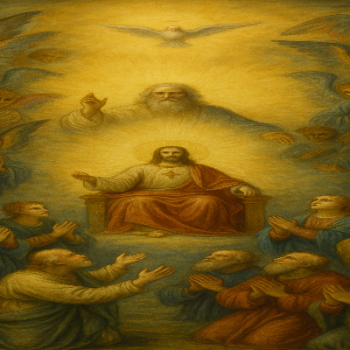
“Remember man, thou art dust, and unto dust thou shalt return.”
It is the season when the faithful are reminded that they are sinners who will die. While that may not be the most uplifting of concepts, the call to repentance and the reminder of our mortality has a long and meaningful history in the Catholic tradition.
In this essay, I will examine three subjects that are vital to the Catholic teachings on repentance and mortality: ashes, Lent, and the significance of the number forty.
Ashes have multiple meanings and uses in the biblical tradition. First, ashes or dust are symbolic of the life cycle. While likely intended to be metaphorical or symbolic, the creation narratives tell how God made human beings out of dust. (See Genesis 2:7). Upon death, the body “Returns to the earth as it once was, and the life breath [i.e., the soul] returns to God who gave it.” (Ecclesiastes 12:6-7).
In this sense, ashes are a reminder of the brevity of life and of one’s impending death (memento mori). There are two primary reasons why being reminded of one’s death is beneficial. First, it imbues life with a sense of urgency. Knowing one’s limited time should spur us to live as fully as God intended. Second, since God will judge the soul at the time of death, memento mori crystalizes the importance of living in accord with the will of God.
Additionally, ashes are used to signify repentance. Such use of ashes is seen throughout Scripture. In Jeremiah 25:34, God commands the Israelites to “wallow in ashes.” Other examples include King David using ashes in response to committing adultery (2 Samuel 12:13-16) and Job covering himself in ashes as a sign of repentance (Job 42:6). The long tradition of the use of ashes as a sign of sorrow and repentance is continued with Lent, which commences on Ash Wednesday.
The word Lent is an Old English term for Spring. Traditionally, it has been associated with a period of contemplation and reflection on those things that hinder spiritual growth. This is often accomplished by prayer and fasting so the faithful can be better prepared for the feast of the Resurrection (Easter). Furthermore, through prayer and fasting, Catholics are disposed to a more fruitful reception of the graces Christ merited by His passion and death.
In a sense, the Lenten season is meant to draw us into Christ’s temptation in the desert. Indeed, Lent is based on the depiction of Christ’s forty days in the desert. “Jesus was led by the Spirit into the desert to be tempted by the devil. He fasted for forty days and forty nights.” (Matthew 4:1-11). The number forty may possess its own significance, a topic I will address below.
The importance of Lent is ingrained in the Church’s liturgical practice. Pope Paul VI put it this way, “The time of Lent preserves its penitential character. The days of penitence to be observed under obligation throughout the Church are all Fridays and Ash Wednesday, that is to say, the first days of Great Lent, according to the diversity of rites. Their substantial observance binds gravely” (Paenitemini, III, norm II).
In the Catholic Church, Lent commences on Ash Wednesday, forty days before Easter. Ash Wednesday, so named for the tradition of placing ashes on the forehead of penitents, can occur on any day from February 4 to March 11, depending on the date of Easter.
The Lenten season emphasizes three pillars of the spiritual life: prayer, fasting, and almsgiving. While oversimplifying the matter, prayer is a conversation with God, a lifting up of the heart and mind to the Divine. Moreover, prayer is the efficient cause of both fasting and almsgiving.
The Bible depicts numerous instances of fasting, often within the context of repentance. However, fasting is also a weapon used to subdue the flesh. Owing to the effect of original sin, the body rebels against the soul. The instincts and passions (sex, food, et al.) war against the rational nature of the soul. The purpose of fasting is to “tame” these uncontrolled instincts and passions and to bring them, once more, into submission to the soul. Initially, the fasting period in preparation for Easter did not exceed two or three days. However, forty days were already customary by the time of the Council of Nicaea in 325 AD.
Almsgiving – giving money or material goods to the poor – is an act of charity. Time has somewhat changed the connotation of charity, but the Latin translation is caritas, meaning “love.” In this context, when we give to those in need, we imitate God, who is love.
The final element of the Lenten season that I will examine is the spiritual meaning and significance of the number forty. Examples of the use of forty appear throughout the Bible. The rain that caused the Great Flood lasted forty days and nights, the Israelites wandered in the desert for forty years, Jesus fasted for forty days, and, of course, Lent lasts forty days. What, if any, importance should we infer from the use of forty in Scripture?
There is no one theory as to why the number forty is so prevalent in the Bible. The most likely reason is that forty is used as an indefinite pronoun intended to suggest a few, some, or many. It may be used to connote a few days, some months, or many years. Another possibility is that forty is intended to signify a period of spiritual testing or assessment. This appears to be the view in Judaism. Similarly, Saint Augustine saw the “perfection of the Law” in the number forty. Unfortunately, there is no definitive answer regarding the significance of the number forty in Scripture.
Lent is a journey that begins with a reminder of our mortality and the need for repentance. However, this journey, begun in ashes, begun in sorrow, ends with the victory of the Resurrection, ends with the joy of the Risen Christ.













